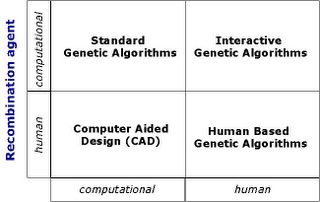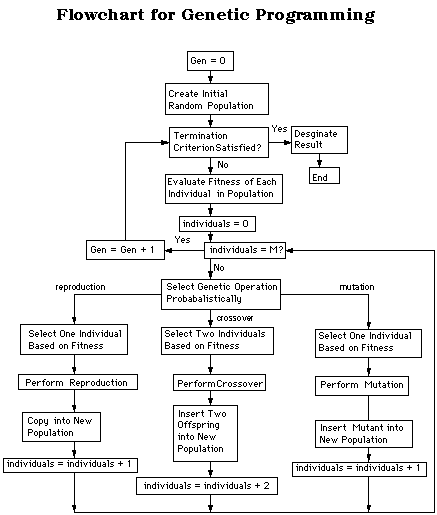Genetic Algorithm Game Programming
Methodology Optimization problems. In a genetic algorithm, a population of candidate solutions (called individuals, creatures, or phenotypes) to an optimization. Genetic algorithm tutorial in plain english. Genetic Algorithms in Plain English. Introduction. The aim of this tutorial is to explain genetic algorithms. GitHub The code is now on a GitHub repository. Feel free to contribute! Controls Save Population: Saves current population locally. Restore Saved Population: Restore.
- Methods of representation; Methods of selection; Methods of change; Other problem-solving techniques; Concisely stated, a genetic algorithm (or GA for short) is a.
- In artificial intelligence, genetic programming (GP) is an evolutionary algorithm-based methodology inspired by biological evolution to find computer programs that.
- GENETIC ALGORITHMS AND GENETIC PROGRAMMING John R. Koza Consulting Professor (Medical Informatics) Department of Medicine School of Medicine Consulting Professor.
- The first annual 'Humies' competition was held at the 2004 Genetic and Evolutionary Computation Conference (GECCO-2004) in Seattle. Entries were solicited for cash.
- A genetic algorithm is an algorithm that imitates the process of natural selection. Natural selection is a central concept of evolution: some organisms have traits.
- For more details about the neural network, the programming, click here : http:// (french) This is an implementation of a.
Genetic programming - Wikipedia, the free encyclopedia. In artificial intelligence, genetic programming (GP) is an evolutionary algorithm- based methodology inspired by biological evolution to find computer programs that perform a user- defined task. Essentially GP is a set of instructions and a fitness function to measure how well a computer has performed a task. It is a specialization of genetic algorithms (GA) where each individual is a computer program. It is a machine learning technique used to optimize a population of computer programs according to a fitness landscape determined by a program's ability to perform a given computational task. History[edit]In 1. GP began with the evolutionary algorithms first used by Nils Aall Barricelli applied to evolutionary simulations.[1] In the 1.

Ingo Rechenberg and his group were able to solve complex engineering problems through evolution strategies as documented in his 1. Ph. D thesis and the resulting 1. John Holland was highly influential during the 1. In 1. 96. 4, Lawrence J. Fogel, one of the earliest practitioners of the GP methodology, applied evolutionary algorithms to the problem of discovering finite- state automata. Later GP- related work grew out of the learning classifier system community, which developed sets of sparse rules describing optimal policies for Markov decision processes.
In 1. 98. 1 Richard Forsyth evolved tree rules to classify heart disease.[2] The first statement of modern "tree- based" genetic programming (that is, procedural languages organized in tree- based structures and operated on by suitably defined GA- operators) was given by Nichael L. Cramer (1. 98. 5).[3] This work was later greatly expanded by John R. Koza, a main proponent of GP who has pioneered the application of genetic programming in various complex optimization and search problems.[4]Gianna Giavelli, a student of Koza's, later pioneered the use of genetic programming as a technique to model DNA expression.[5]In the 1. GP was mainly used to solve relatively simple problems because it is very computationally intensive.

Recently GP has produced many novel and outstanding results in areas such as quantum computing, electronic design, game playing, cyberterrorism prevention,[6]sorting, and searching, due to improvements in GP technology and the exponential growth in CPU power.[7] These results include the replication or development of several post- year- 2. GP has also been applied to evolvable hardware as well as computer programs. Developing a theory for GP has been very difficult and so in the 1. GP was considered a sort of outcast among search techniques.[citation needed]Program representation[edit]GP evolves computer programs, traditionally represented in memory as tree structures.[3] Trees can be easily evaluated in a recursive manner. Every tree node has an operator function and every terminal node has an operand, making mathematical expressions easy to evolve and evaluate. Thus traditionally GP favors the use of programming languages that naturally embody tree structures (for example, Lisp; other functional programming languages are also suitable). Non- tree representations have been suggested and successfully implemented, such as linear genetic programming which suits the more traditional imperative languages [see, for example, Banzhaf et al.
The commercial GP software Discipulus uses automatic induction of binary machine code ("AIM")[9] to achieve better performance. µGP[1. 0] uses directed multigraphs to generate programs that fully exploit the syntax of a given assembly language. Most non- tree representations have structurally noneffective code (introns). Such non- coding genes may seem to be useless, because they have no effect on the performance of any one individual. However, experiments seem to show faster convergence when using program representations—such as linear genetic programming and Cartesian genetic programming—that allow such non- coding genes, compared to tree- based program representations that do not have any non- coding genes.[1. Genetic operators[edit]The main operators used in evolutionary algorithms such as GP are crossover and mutation.
Crossover[edit]Crossover is applied on an individual by simply switching one of its nodes with another node from another individual in the population. With a tree- based representation, replacing a node means replacing the whole branch. This adds greater effectiveness to the crossover operator.
The expressions resulting from crossover are very different from their initial parents. Mutation[edit]Mutation affects an individual in the population. It can replace a whole node in the selected individual, or it can replace just the node's information. To maintain integrity, operations must be fail- safe or the type of information the node holds must be taken into account. For example, mutation must be aware of binary operation nodes, or the operator must be able to handle missing values. Other approaches[edit]The basic ideas of genetic programming have been modified and extended in a variety of ways: Extended Compact Genetic Programming (ECGP)Embedded Cartesian Genetic Programming (ECGP)Probabilistic Incremental Program Evolution (PIPE)Strongly Typed Genetic Programming (STGP)Meta- Genetic Programming[edit]Meta- Genetic Programming is the proposed meta learning technique of evolving a genetic programming system using genetic programming itself. It suggests that chromosomes, crossover, and mutation were themselves evolved, therefore like their real life counterparts should be allowed to change on their own rather than being determined by a human programmer.
Meta- GP was formally proposed by JГјrgen Schmidhuber in 1. Doug Lenat's Eurisko is an earlier effort that may be the same technique. It is a recursive but terminating algorithm, allowing it to avoid infinite recursion. Critics of this idea often say this approach is overly broad in scope.
However, it might be possible to constrain the fitness criterion onto a general class of results, and so obtain an evolved GP that would more efficiently produce results for sub- classes. This might take the form of a Meta evolved GP for producing human walking algorithms which is then used to evolve human running, jumping, etc. The fitness criterion applied to the Meta GP would simply be one of efficiency. For general problem classes there may be no way to show that Meta GP will reliably produce results more efficiently than a created algorithm other than exhaustion.
See also[edit]References and notes[edit]^Barricelli, Nils (1. Esempi numerici di processi di evoluzione" [Numerical examples of evolution processes]. Methodos (in Italian) 6 (2. Kybernetes 1. 98. Cramer, 1. 98. 5^genetic- programming. Home- Page^The Genetic Coding of Behavioral Attributes in Cellular Automata. Artificial Life at Stanford 1.
Stanford, California, 9. USA.^James V. Hansen, Paul Benjamin Lowry, Rayman Meservy, and Dan Mc. Donald (2. 00. 7). Genetic programming for prevention of cyberterrorism through dynamic and evolving intrusion detection," Decision Support Systems (DSS), vol. John R. Koza. "3.
Human- Competitive Results Produced by Genetic Programming". Garnett Wilson and Wolfgang Banzhaf. A Comparison of Cartesian Genetic Programming and Linear Genetic Programming".^(Peter Nordin, 1. Banzhaf et al., 1. Section 1. 1. 6. 2- 1. Micro. GP page on Source. Forge, complete with tutorials and wiki^Julian F.
Miller. "Cartesian Genetic Programming". Janet Clegg; James Alfred Walker; Julian Francis Miller.
A New Crossover Technique for Cartesian Genetic Programming". THESIS ON LEARNING HOW TO LEARN, METALEARNING, META GENETIC PROGRAMMING, CREDIT- CONSERVING MACHINE LEARNING ECONOMYExternal links[edit].